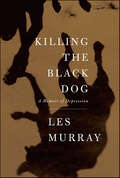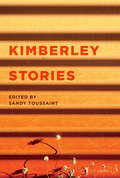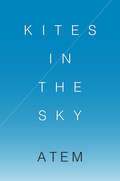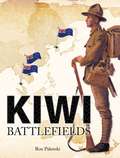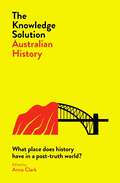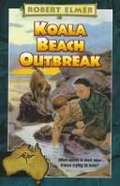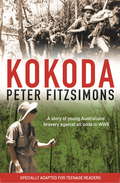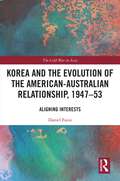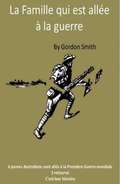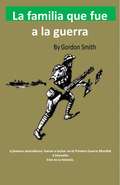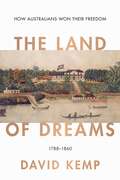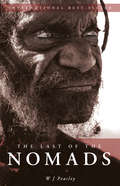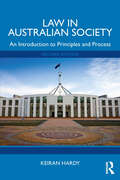- Table View
- List View
Killing the Black Dog: A Memoir of Depression
by Les MurrayIn 1988, shortly after moving from Sydney back to his birthplace in the rural New South Wales hamlet of Bunyah, Les Murray was struck with depression. In the months that followed, the "Black Dog" (as he calls it) ruled his life. He raged at his wife and children. He ducked a parking ticket on grounds of insanity, and begged a police officer to shoot him rather than arrest him. For days on end he lay in despair, a state in which, as he puts it precisely, "you feel beneath help." Killing the Black Dog is Murray's recollection of those awful days: brief, pointed, wise, and full of beauty in the way of his poetry. The prose text—delicately balanced between personal and informative—gives a glimpse of the imprint that depression can leave on a life. The accompanying poems show their roots in his crisis—a crisis from which, he reports toward the close of this poignant book, he has fully recovered. "My thinking is no longer jammed and sooty with resentment," he recalls. "I no longer wear only stretch-knit clothes and drawstring pants. I no longer come down with bouts of weeping or reasonless exhaustion. And I no longer seek rejection in a belief that only bitterly conceded praise is reliable." Killing the Black Dog is a crucial chapter in the life of an outstanding poet.
Kimberley Stories
by Sandy ToussaintA journey of discovery into one of Australia’s most intriguing and exotic regions, the Kimberley, this anthology features both artwork and writing. It includes contributions from talents such as Kate Auty, Peter Bibby, Lesley Corbett, Steve Hawke, Donna Bing-Ying Mak, Stephen Scourfield, Pat Mmanjun Bananga Torres, and Jacqueline Wright, and will appeal to a wide range of readers—travelers, fans of indigenous works, and those interested in desert culture and landscape.
Kites in the Sky
by AtemKites in the Sky distills the wisdom of one lifetime, asking questions, pondering possibilities and embracing simplicity. These humble thought-children, born from love and based on haiku, will give rest to your heart.
Kiwi Battlefields
by Ron PalenskiThe history behind the major battlefields in which New Zealand soldiers fought
Kiwis Might Fly: A New Zealand Adventure
by Polly EvansNEW YORK TIMES BESTSELLERPolly Evans was a woman with a mission. Before the traditional New Zealand male hung up his sheep shears for good, Polly wanted to see this vanishing species with her own eyes. Venturing into the land of giant kauri trees and smaller kiwi birds, she explores the country once inhabited by fierce Maori who carved their enemies' bones into cutlery, bushwhacking pioneers, and gold miners who lit their pipes with banknotes--and comes face-to-face with their surprisingly tame descendants. So what had become of the mighty Kiwi warrior? As Polly tears through the countryside at seventy-five miles an hour, she attempts to solve this mystery while pub-crawling in Hokitika, scaling the Southern Alps, and enduring a hair-raising stay in a mining town where the earth has been known to swallow houses whole. And as she chronicles the thrills and travails of her extraordinary odyssey, Polly's search for the elusive Kiwi comes full circle--teaching her some hilarious and surprising lessons about motorcycles, modern civilization, and men.From the Trade Paperback edition.
Knowledge Solution: What place does history have in a post-truth world?
by Anna ClarkWhat can we learn from recurring events across the recent history of Australia, of colonisation, nationalism, racism, fighting on foreign shores, land booms, industrial campaigns and culture wars? Arguments about the discipline of Australian History, from thinkers across the ideological and historical spectrum, are distilled in these extracts and essays. The Knowledge Solution: Australian History is the second collection in a series that draws from the remarkable books published by Australia's oldest university press. Contributors include: Bain Attwood, Geoffrey Blainey, Michael Cannon, Raffaello Carboni, Manning Clark, Peter Cochrane, James Curran, Mark Davis, Alexandra Dellios, Richard Evans, Michele Grossman, Marcia Langton, Helen MacDonald, Stuart Macintyre, Janet McCalman, Mark McKenna, Lisa Palmer, Ray Parkin, Rachel Perkins, Robert Reynolds, John Rickard, Kathryn Shain, Peter Spearritt, Peter Sutton, Rebe Taylor, Maureen Tehan, David Unaipon, Jo Wainer, Stuart Ward, Ellen Warne, Myra Willard and Alexis Wright.
Koala Beach Outbreak (Adventures Down Under #7)
by Robert ElmerBook 7 in the Adventures Down Under series for middle-grade readers. The McWaids befriend Jasper, a young immigrant from China with an important secret. The prejudice of the town endangers the lives of the miners threatened with typhoid.
Kokoda Trail for Dummies
by Peter WilliamsEverything you need to know about the Kokoda Trail and its place in Australian history Interest in the Kokoda Trail is growing rapidly among many Australians, both for its attraction as a hiking destination and for its historical significance. Kokoda For Dummies offers a fast track tool for learning everything you need to know about this unique thoroughfare, in one concise volume. Part history book, part practical guide, Kokoda For Dummies is perfect both for those considering following our Diggers’ footsteps along ‘the track’ or armchair travellers who want to learn about its history. Covering the full history of the Kokoda Trail, from its beginnings as an overland mail route to the fierce battles between the Australians and the Japanese that took place along its length during World War II, the book also includes important information on walking the trail yourself. From the steps you need to take to get ready to what to bring, Kokoda For Dummies is the definitive resource for anyone looking for a comprehensive overview of this significant landmark. Focuses on walking the track as a pilgrimage and a history lesson for history buffs and hiking enthusiasts alike Covers the health and safety concerns involved with walking the track, including a basic Kokoda itinerary Contains eyewitness accounts of the Kokoda battles gleaned from interviews conducted with Australian and Japanese war veterans A comprehensive but accessible history of the Kokoda Trail and its significance to Australia, in one volume.
Kokoda: Younger Readers
by Peter FitzsimonsA story of young Australians' mateship and bravery against all odds in WWIIFor Australians, Kokoda is the iconic battle of World War II, yet few people know just what happened - and just what our troops achieved. In this new edition of his bestselling account of this seminal battle, Peter FitzSimons tells the Kokoda story in a gripping, moving story specially geared for high-school age readers. Conditions on the track were hellish - rain was constant, the terrain close to inhospitable, food and ammunition supplies were practically non-existent and the men constantly battled malaria and dysentery, as well as the Japanese. Kokoda was a defining battle for Australia - a small force of young, ill-equipped Australians engaged a highly experienced and hitherto unstoppable Japanese force on a narrow, precarious jungle track - and defeated them.Prase for the original edition:'an engrossing narrative, beautifully controlled by a master storyteller' The Sydney Morning Herald
Kon-Tiki: Across the Pacific by Raft
by Thor HeyerdahlThis book recounts a groups' travels across the Pacific ocean on a raft
Koombana Days
by Annie BoydThe elegant, ultra-modern SS Koombana arrived in Western Australia in March 1909; after only three years of service in the North West of Australia, the ship and her entire complement disappeared in a late-summer cyclone off the Pilbara coast in 1912. All 156 lives were lost but the wreck was never found. This thoroughly researched and compelling book comes closer than ever before to solving the mystery of Australia’s most significant maritime disaster. Author Annie Boyd spent months camping along the coast, diving and investigating wrecks, researching the Koombana, and meeting with descendants of those lost in the tragedy. This insightful account is the culmination of her work, which includes a 20,000 page online resource with background material and primary sources.
Korea and the Evolution of the American-Australian Relationship, 1947–53: Aligning Interests (The Cold War in Asia)
by Daniel FazioFazio examines the significance of the US-Australian Korean engagement, 1947–53, in the evolution of the relationship between the two nations in the formative years of the Cold War. In the aftermath of World War Two, divergent American and Australian strategic and security interests converged and then aligned on the Korean peninsula. Fazio argues that the interactions between key US and Australian officials throughout their Korean engagement were crucial to shaping the nature of the evolving relationship and the making of the alliance between the two nations. The diplomacy of Percy Spender, John Foster Dulles, and James Plimsoll was particularly crucial. He demonstrates that the American evaluation of the geo-strategic significance of Korea was a significant factor in the making of the ANZUS alliance and events in Korea remained central to the evolving US-Australian relationship. Their Korean engagement showed the US and Australia had similar and overlapping, rather than identical interests, and that their relationship was much more nuanced and problematic than commonly perceived. Fazio challenges the Australian mythology on the origins of the ANZUS Treaty and presents a cautionary insight into the limits of Australia’s capacity to influence US policy to benefit its interests. An insightful read for diplomatic historians, providing greater depth to understanding the broader historical context of the trajectory of the US-Australian relationship and alliance since the beginning of the Cold War.
Kosciuszko: The incredible life of the man behind the mountain
by Anthony SharwoodHeroes are hard to come by - but there's one man whose legend has stood the test of two centuries, and whose name sits on Australia's highest peak. Tadeusz Kosciuszko: freedom fighter, friend of Thomas Jefferson and champion of liberty on two continents. Bestselling author Anthony Sharwood finds out why he's the hero the world needs right now.Kosciuszko - our iconic highest mountain - is a name familiar to all Australians. But how many people know who the mountain is named after?Tadeusz Kosciuszko, who lived from 1746 to 1817, is the most famous person Australians probably know absolutely nothing about. A military engineer, freedom fighter, and champion of human rights, this extraordinary revolutionary was crucial to the success of the American War of Independence, then bravely led an uprising against Russia and other invaders in his native Poland, promising freedom and equality to all who joined his cause.In his day, Kosciuszko was loved and respected across Europe and America. His great friend Thomas Jefferson called him 'as pure a son of liberty as I have ever known', while Kosciuszko would later challenge Jefferson to live up to the famous words 'All men are created equal' by bequeathing his American funds to free enslaved people, including those on Jefferson's plantation.Bestselling author Anthony Sharwood (From Snow to Ash; The Brumby Wars) has spent a lifetime walking, skiing and writing about Kosciuszko National Park. Now he sets off on the trail of the man himself, travelling across the USA, Poland and Switzerland to key sites in Kosciuszko's life. Returning to Australia where a potential name change from Mt Kosciuszko to an Indigenous name is hotly debated, he walks with the area's traditional owners and discovers the ancient history of Australia's highest peak.Kosciuszko's life and legacy is enthralling, inspiring and indispensable. But is that reason enough to keep his name on the mountain?
Krithia: The Forgotten Anzac Battle of Gallipoli
by Mat McLachlanThe Second Battle of Krithia has existed largely in the shadows of the bigger Gallipoli story. It is, however, one of the most poignant and tragic tales of World War I. The fascinating story has been brought to light at last by bestselling military historian Mat McLachlan, author of The Cowra Breakout.In May 1915 during World War I, British units tried to capture the village of Krithia on the southern tip of the Gallipoli peninsula. Australian and New Zealand units were sent to reinforce the British. On 8 May, the Anzac troops took part in a bloody battle near Krithia. Advancing across a featureless plain in broad daylight, with no idea where the Turkish defenders were, the Anzacs came under a hail of machine-gun and rifle fire. The Australians managed to advance, but got nowhere near the village and dug in well short of their objective. The New Zealanders on their left fared no better. By the end of the day, over 1800 Anzac troops had been killed or wounded.Supported by first-hand accounts and oral history, Krithia features the stories of a number of Australians, New Zealanders and Turks - some who survived, some who didn't. The battle of Krithia is a tale of bravery and sacrifice, and a vivid portrait of men doing their best under hellish conditions. It's a great Australian story that hasn't been told - until now.
La Famille qui est allée à la guerre
by Gordon Smith Bibi Sahida DilmamodeThis book is on the life of a family during the First World War. The Family that went to War” is set back in the early 1900’s during wartime. The story follows six Australian family members as they each choose to go and fight for varying personal reasons. The book recounts their highs, lows, struggles as well as triumphs. It is both inspiring and heartbreaking about what these people were leaving behind (including families and children) and what hardships they faced on their journeys. The story covers their journeys through the war in Europe and explores some of their complex characteristics and the summary of the lives of the three who returned. It also highlights the anguish of the mother whose son was lost on the battlefields of Fromelles and whose body still as not been identified one hundred years later’ Six family members went to war. Only three returned!
La Niña and the Making of Climate Optimism: Remembering Rain
by Julia MillerThis book examines the deep connection Australians have with their climate to understand contemporary views on human-induced climate change. It is the first study of the Australian relationship with La Niña and it explains how fundamental this relationship is to the climate change debate both locally and globally. While unease with the Australian environment was a hallmark of early settler relations with a new continent, this book argues that the climate itself quickly became a source of hope and linked to progress. Once observed, weather patterns coalesced into recognizable cycles of wet and dry years and Australians adopted a belief in the certainty of good seasons. It was this optimistic response to climate linked to La Niña that laid the groundwork for this relationship with the Australian environment. This book will appeal to scholars and students of the environmental humanities, history and science as well as anyone concerned about climate change.
La familia que fue a la guerra
by Gordon Smith Carla Jessica ScottaHistoria de seis australianos durante la Primera Guerra Mundial. Seis fueron a pelear; solo tres regresaron. En 1914, Australia se unió a Inglaterra y le declaró la guerra a Alemania y sus aliados. En la pequeña localidad de Cootamundra, en Nueva Gales del Sur, seis jóvenes australianos, todos de la misma familia, se unieron al combate de manera individual. Este relato narra sus viajes por Galípoli y el Frente Occidental. El relato también cuenta sobre el tiempo que pasaron en Egipto, Inglaterra y Francia cuando no estaban peleando. Esta es la historia de una familia y cómo se vio afectada por una guerra que transcurría del otro lado del mundo. Narra las batallas, las heridas y las enfermedades que debieron soportar estos jóvenes, así como momentos menos crueles. Un relato ameno que muestra cómo fueron esos tiempos de oscuridad. Género: HISTORIA / Australia y Nueva Zelanda Género secundario: BIOGRAFÍA Y AUTOBIOGRAFÍA / Militar Idioma: Español
Labor'S Conflict
by Tom Bramble Rick KuhnOnce widely regarded as the workers greatest hope for a better world, the ALP today would rather project itself as a responsible manager of Australian capitalism. Labor's Conflict provides an insightful account of the transformations in the Party's policies, performance and structures since its formation. Seasoned political analysts, Tom Bramble and Rick Kuhn offer an incisive appraisal of the Party's successes and failures, betrayals and electoral triumphs in terms of its competing ties with bosses and workers. The early chapters outline diverse approaches to understanding the nature of the Party and then assess the ALP's evolution in response to major social upheavals and events, from the strikes of the 1890s, through two World Wars, the Great Depression, and the post-war boom. The records of the Whitlam, Hawke, Keating, Rudd and Gillard governments are then dissected in detail. The compelling conclusion offers alternatives to the Australian Labor Party, for those interested in progressive change.
Land of Dreams: How Australians Won Their Freedom, 1788-1860
by David KempThe Land of Dreams: How Australians Won Their Freedom, 1788-1860 tells the story of how Australians became a free people, gaining the liberties they desired to take control of their own lives, the right to govern themselves and the capacity to address their own political problems through democratic institutions. As the first book in a path-breaking five-volume Australian Liberalism series, it tells the story of how Australians laid the foundations for one of the world's most successful countries, with unprecedented levels of personal liberty and social equality. Australians did not have to fight a war for their independence, but neither did they gain it without a struggle against policies imposed by a British government in which they had no part. It required a brilliant political campaign that walked to the edge of violent resistance and from it Australia gained a national identity and political leaders who would write their constitutions, introduce democracy and later lead the successful political fight for one Australian nation.
Language Contact in the Early Colonial Pacific
by Emanuel J. DrechselThis volume presents a historical-sociolinguistic description and analysis of Maritime Polynesian Pidgin. It offers linguistic and sociohistorical substantiation for a regional Eastern Polynesian-based pidgin, and challenges conventional Eurocentric assumptions about early colonial contact in the eastern Pacific by arguing that Maritime Polynesian Pidgin preceded the introduction of Pidgin English by as much as a century. Emanuel J. Drechsel not only opens up new methodological avenues for historical-sociolinguistic research in Oceania by a combination of philology and ethnohistory, but also gives greater recognition to Pacific Islanders in early contact between cultures. Students and researchers working on language contact, language typology, historical linguistics and sociolinguistics will want to read this book. It redefines our understanding of how Europeans and Americans interacted with Pacific Islanders in eastern Polynesia during early encounters and offers an alternative model of language contact.
Last of the Nomads
by W J Peaseley'Peasley's description of the events … is informative, compassionate, exciting and at times deeply moving.' —Don Grant, Australian Book Review 'The intriguing story of [the rescue of an elderly couple believed to be the last Australian nomads] and how they survived alone for the previous 30 years or so in the unrelenting western Gibson Desert region of WA, is fascinating reading.' — Chris Walters, The West Australian 'This is a most remarkable book about the recovery during the 1977 drought of an ailing Aboriginal nomadic couple, living in desert regions of Western Australia.' — The National Times Warri and Yatungka were believed to be the last of the Mandildjara tribe of desert nomads to live permanently in the traditional way. Their deaths in the late 1970s marked the end of a tribal lifestyle that stretched back more than 30,000 years. The Last of the Nomads tells of an extraordinary journey in search of Warri and Yatungka.
Latham at Large
by Mark LathamMark Latham is, by his own admission, the most outspoken, rebellious, thoroughly uncontrollable former leader in Labor Party history.In these brilliantly written opinion pieces Latham pulls no punches as he scrutinises the Australian political landscape, looking at everything from climate change to Clive Palmer, to what went wrong with Rudd-Gillard and what's now wrong with Abbott. Beyond politics, Latham dabbles in his other great interests, such as critiquing the modern media and explaining his fascination with horse racing. His hilarious 'Henderson Watch' columns and other satirical writing also feature in Latham at Large.Mark Latham has a formidable intellect and a forensic ability to get to the bottom of things. This is an entertaining, thought-provoking, sometimes scathing, often humorous collection from a man who is not afraid to speak his mind. There is no one else like him in Australian public life.
Laugh, You Buggers, Laugh: Selected poems (1967-1979) and the life and times that inspired them
by Nigel GrayLaugh, You Buggers, Laugh is no ordinary collection of poems. Nigel Gray led an extraordinary life in extraordinary times. He was a political activist and performance poet in the UK during the days of rage and hope, flower power and free love, radical social change and political upheaval that typified the 1960s and 70s. He travelled on political forays to Southeast Asia, Africa, Ireland, and mainland Europe. This is a selection of poems from that time set in a context that explains the situations and experiences that inspired them. Nigel Gray, an Irish-born West Australian, is the multi-award-winning author of a hundred published books for adults and children.
Law and the Dead: Technology, Relations and Institutions
by Marc TrabskyThe governance of the dead in the eighteenth and nineteenth centuries gave rise to a new arrangement of thanato-politics in the West. Legal, medical and bureaucratic institutions developed innovative technologies for managing the dead, maximising their efficacy and exploiting their vitality. Law and the Dead writes a history of their institutional life in the nineteenth and twentieth centuries. With a particular focus on the technologies of the death investigation process, including place-making, the forensic gaze, bureaucratic manuals, record-keeping and radiography, this book examines how the dead came to be incorporated into legal institutions in the modern era. Drawing on the writings of philosophers, historians and legal theorists, it offers tools for thinking through how the dead dwell in law, how their lives persist through the conduct of office, and how coroners assume responsibility for taking care of the dead. This historical and interdisciplinary book offers a provocative challenge to conventional thinking about the sequestration of the dead in the nineteenth and twentieth centuries. It asks the reader to think through and with legal institutions when writing a history of the dead, and to trace the important role assumed by coroners in the governance of the dead. This book will be of interest to scholars working in law, history, sociology and criminology.
Law in Australian Society: An Introduction to Principles and Process
by Keiran HardyWhat is the ‘rule of law'? How do laws get made? Does our legal and political system achieve justice for all Australians equally? Designed for beginners as well as non-law students, this textbook provides a comprehensive and accessible guide to understanding Australia's system of law and government.Law in Australian Society explains legislation and case law, courts, and the doctrine of precedent. Keiran Hardy examines the roles played by parliaments, politics, and the media. He explains founding principles, including democracy, liberalism, the separation of powers, and federalism. Human rights and justice are highlighted, with an emphasis on First Nations Peoples and the law. The book explains criminal responsibility and the justice system, including police powers and the criminal trial. It concludes with case studies of cybercrime and counterterrorism laws to illustrate law reform in action. This second edition has been fully updated throughout, including recent legislation, cases, and topical issues from Australian law and politics, including from the COVID-19 pandemic and the recent referendum on an Indigenous Voice to Parliament. Each chapter features practical examples, chapter summaries and review questions together with a glossary of key terms. Concise, accessible and up-to-the-minute, this is a vital guide for anyone seeking to understand Australian law and government.
